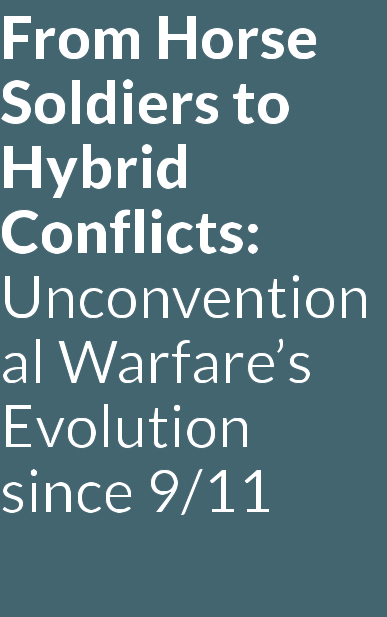

© 2023-2024 Oriental Institute, The Czech Academy of Sciences, Kevin L. Schwartz, and Ameem Lutfi


The
stark
contrast
of
the
beginning
and
end
of
U.S.
military
operations
in
Afghanistan
forces
a
reflection
on
the
trajectory
of
unconventional
warfare
over
two
decades
of
the
Global
War
on
Terror.
The
early
days
of
U.S.
operations
in
Afghanistan
vividly
showcased
the
effectiveness
of
unconventional
warfare.
The
rugged
images
of
U.S.
Army
Green
Berets
on
horseback,
taking
over
the
country
together
with
the
Northern
Alliance,
as
famously
featured
in
the
movie
12
Strong
(2018),
marked
a
departure
from
the
technical
images
emitted
from
missiles
and
planes
equipped
with
cameras
during
Operation
Desert
Storm
a
decade
earlier.
The
initial
defeat
and
retreat
of
the
Taliban
seemed
to
undo
the
U.S.
Armed
Forces’
aversion
to
unconventional
warfare
since
the
Vietnam
War,
rekindling
the
potential
of
special
operation
forces
and
clandestine
intelligence
services.1
Undoubtedly,
the
Global
War
on
Terror
has
shaped
the
trajectory of special warfare, leaving a lasting impact on both military conflicts and their depictions in popular culture.
However,
over
time,
the
initial
optimism
soon
yielded
to
a
more
intricate
reality.
The
infamous
2017
quote
from
President
Trump
that
“We
are
not
nation-building
again.
We
are
killing
terrorists”
epitomized
the
shifting
focus
of
U.S.
efforts
in
Afghanistan.
Gradually,
the
focus
transitioned
from
fostering
collaboration
and
nurturing
bonds
with
Afghan
forces
to
targeted
man-hunt
operations
and
counterterrorism.
This
strategy
proved
insufficient
in
countering
the
resurgence
of
the
Taliban,
paving
the
way
for
their
return
to
power
in
2021,
accompanied
by
haunting
scenes
from
the
Kabul
airport.
The
tragic
fate
of
countless
Afghan
commandos
and
interpreters,
abandoned
and
subsequently
executed
by
the
Taliban,
draws
a
distressing
historical
parallel
to
the
plight
of
the
Montagnards
in
Vietnam,
who
stood
alongside
U.S.
troops
only
to
be
forsaken
as
a
persecuted
minority.
Such
instances
serve
as
bitter
reminders
of
the
complex
dynamics
and
human
costs
intrinsic to unconventional warfare.
Within
the
realm
of
U.S.
special
operation
forces,
the
U.S.
Army
Special
Forces,
commonly
known
as
Green
Berets,
have
long
been
synonymous
with
unconventional
warfare,
entrusted
with
tasks
encompassing
foreign
internal
defense
and
security
force
assistance
to
indigenous
units.
The
Green
Berets
became
popular
after
embedded
author
Robin
Moore
published
his
same-
named
best-seller
book
(1965)
telling
the
daring
operations
of
Green
Berets
in
the
hapless
Vietnam
War,
which
was
later
turned
into
a
billboard
no.
1
hit
song
(1966)
and
a
box-office
hit
movie
(1968).
As
Army
Special
Forces,
the
Green
Berets
have
trained
commandos
and
guerrillas
in
allied
nations
across
the
world
during
the
Cold
War
and
thereafter.2
Yet,
they
have
grappled
with
a
profound
identity
crisis
over
the
past
two
decades
since
9/11.
The
rise
of
surgical
direct-action
operations,
reminiscent
of
special
mission
units
such
as
Delta
Force
and
SEAL
Team
Six
during
pivotal
moments
like
the
capture
of
Saddam
Hussein
and
the
elimination
of
Osama
Bin
Laden,
has
overshadowed
the
more
long-term
engagements
of
unconventional
warfare.
A
recent
study
shows
that
the
allure
of
intensive
language
training,
a
cornerstone
of
Green
Beret
curriculum
,
is
waning
among
the
new
generation:
29%
no
longer
view
it
as
a
pivotal
skill.
A
statement
by
an
anonymous
Green
Beret
in
the
same
study
encapsulates
the
essence
of
the
prevailing
“identity
crisis,”
noting
that
a
generation
reared
on
the
events
of
the
Global
War
on
Terror
and
“the
promise
of
door-kicking
raids,
dynamic
entries,
and
kill/capture
methodologies”
may
find
this
idealized
vision
doesn’t
accord
with
reality.
The
former
ideal
of
the
Green
Berets
as
“
Ph.D.s
who
can
win
a
bar
fight
”
seems
to
be
far
off.
The
decline
in
recruitment
figures
across
the
United
States
further
underscores
this
transformation.
Moreover,
an
unsettling
history
of
war
crimes
and
other
criminal
offenses
committed
by
U.S.
special
operators
prompts
contemplation
on
whether
the
experience
of
the
Global
War
on
Terror
eroded
the
moral
fabric
of
U.S.
special
operation
forces.
Meanwhile,
a
significant
geostrategic
shift
has
also
taken
place.
During
the
Afghanistan
conflict,
the
U.S.
special
operation
forces
relished
a
significant
technological
edge.
Equipped
with
night
vision
goggles
that
bestowed
upon
them
the
ability
to
“
own
the
night
,”
as
well
as
advancements
in
satellite
communication
and
drone
warfare
that
redefined
air
superiority,
the
U.S.
military
held
a
distinct
advantage.
However,
the
global
strategic
landscape
is
in
a
state
of
rapid
flux,
with
the
specter
of
strategic
competition
with
Russia
and
China
looming
large
on
the
horizon.
The
balance
of
technological
power
is
now
undergoing
a
tectonic
shift.
As
the
current
war
in
Ukraine
demonstrates,
engagements
where
both
adversaries
boast
relatively
comparable
advancements
may
soon
define
the
new
standard.
Intriguingly,
the
prophetic
words
of
Colonel
Sam
Trautman,
the
Green
Beret
mentor
of
the
fictional
character
John
Rambo
in
David
Morrell’s
novel
First
Blood
(1972),
resonate
with
a
haunting
significance.
His
premonition,
“To
find
a
man
all
you
have
to
do
is
fly
over
the
spot
where
you
think
he
is,
and
the
machine
will
register
his
body
heat...
And
a
man
like
me,
he
won’t
be
needed.
This
is
the
last
of
something...
I
fear
the
day
when
machines
take
the
place
of
men,”
underscores
the
profound
implications
of
advancing
technology.
As
history evolves, the future of unconventional warriors hangs precariously in the balance.
Nonetheless,
amidst
these
complexities,
unconventional
warriors
will
still
remain
relevant
.
The
convergence
of
human
intelligence
work
and
special
operations
will
persist
as
an
indispensable
element
in
the
hybrid
wars
of
the
future,
mirroring
the
transgressive
capacities
displayed
by
the
OSS
in
the
Second
World
War
and
the
MACV-SOG
during
the
Vietnam
War
as
well
as
the
task
forces
of
the
JSOC
and
the
CIA’s
SAC
during
the
Global
War
on
Terror.
Additionally,
a
renewed
emphasis
on
international
partnerships
to
cultivate
local
capacities
for
resistance
and
reliance,
as
has
been
occurring
across
Scandinavia,
the
Baltics,
and
Ukraine,
will
emerge
as
essential
in
crafting
an
integrated
deterrence
against
the
looming
aggression
of
United
States’
near-peer
adversaries.
As
the
global
landscape
evolves,
marked
by
hybrid
conflicts
and
new
tragedies
unfolding
in
the
aftermath
of
the
Global
War
on
Terror,
the
unfortunate
reality
is
that
warfare
will
persist.
Amidst
this perpetual state of conflict, even as the conventions of war undergo redefinition, warfare will retain its unconventional facet as a transgressive and transformative force to be reckoned with.







If you are interested in contributing an article for
the project, please send a short summary of the
proposed topic (no more than 200 words) and brief
bio to submissions@911legacies.com. For all
other matters, please contact
inquiry@911legacies.com.

CONTACT


The
stark
contrast
of
the
beginning
and
end
of
U.S.
military
operations
in
Afghanistan
forces
a
reflection
on
the
trajectory
of
unconventional
warfare
over
two
decades
of
the
Global
War
on
Terror.
The
early
days
of
U.S.
operations
in
Afghanistan
vividly
showcased
the
effectiveness
of
unconventional
warfare.
The
rugged
images
of
U.S.
Army
Green
Berets
on
horseback,
taking
over
the
country
together
with
the
Northern
Alliance,
as
famously
featured
in
the
movie
12
Strong
(2018),
marked
a
departure
from
the
technical
images
emitted
from
missiles
and
planes
equipped
with
cameras
during
Operation
Desert
Storm
a
decade
earlier.
The
initial
defeat
and
retreat
of
the
Taliban
seemed
to
undo
the
U.S.
Armed
Forces’
aversion
to
unconventional
warfare
since
the
Vietnam
War,
rekindling
the
potential
of
special
operation
forces
and
clandestine
intelligence
services.1
Undoubtedly,
the
Global
War
on
Terror
has
shaped
the
trajectory
of
special
warfare,
leaving
a
lasting
impact
on
both
military
conflicts
and
their
depictions in popular culture.
However,
over
time,
the
initial
optimism
soon
yielded
to
a
more
intricate
reality.
The
infamous
2017
quote
from
President
Trump
that
“We
are
not
nation-building
again.
We
are
killing
terrorists”
epitomized
the
shifting
focus
of
U.S.
efforts
in
Afghanistan.
Gradually,
the
focus
transitioned
from
fostering
collaboration
and
nurturing
bonds
with
Afghan
forces
to
targeted
man-hunt
operations
and
counterterrorism.
This
strategy
proved
insufficient
in
countering
the
resurgence
of
the
Taliban,
paving
the
way
for
their
return
to
power
in
2021,
accompanied
by
haunting
scenes
from
the
Kabul
airport.
The
tragic
fate
of
countless
Afghan
commandos
and
interpreters,
abandoned
and
subsequently
executed
by
the
Taliban,
draws
a
distressing
historical
parallel
to
the
plight
of
the
Montagnards
in
Vietnam,
who
stood
alongside
U.S.
troops
only
to
be
forsaken
as
a
persecuted
minority.
Such
instances
serve
as
bitter
reminders
of
the
complex
dynamics
and
human
costs intrinsic to unconventional warfare.
Within
the
realm
of
U.S.
special
operation
forces,
the
U.S.
Army
Special
Forces,
commonly
known
as
Green
Berets,
have
long
been
synonymous
with
unconventional
warfare,
entrusted
with
tasks
encompassing
foreign
internal
defense
and
security
force
assistance
to
indigenous
units.
The
Green
Berets
became
popular
after
embedded
author
Robin
Moore
published
his
same-named
best-seller
book
(1965)
telling
the
daring
operations
of
Green
Berets
in
the
hapless
Vietnam
War,
which
was
later
turned
into
a
billboard
no.
1
hit
song
(1966)
and
a
box-office
hit
movie
(1968).
As
Army
Special
Forces,
the
Green
Berets
have
trained
commandos
and
guerrillas
in
allied
nations
across
the
world
during
the
Cold
War
and
thereafter.2
Yet,
they
have
grappled
with
a
profound
identity
crisis
over
the
past
two
decades
since
9/11.
The
rise
of
surgical
direct-
action
operations,
reminiscent
of
special
mission
units
such
as
Delta
Force
and
SEAL
Team
Six
during
pivotal
moments
like
the
capture
of
Saddam
Hussein
and
the
elimination
of
Osama
Bin
Laden,
has
overshadowed
the
more
long-
term
engagements
of
unconventional
warfare.
A
recent
study
shows
that
the
allure
of
intensive
language
training,
a
cornerstone
of
Green
Beret
curriculum
,
is
waning
among
the
new
generation:
29%
no
longer
view
it
as
a
pivotal
skill.
A
statement
by
an
anonymous
Green
Beret
in
the
same
study
encapsulates
the
essence
of
the
prevailing
“identity
crisis,”
noting
that
a
generation
reared
on
the
events
of
the
Global
War
on
Terror
and
“the
promise
of
door-kicking
raids,
dynamic
entries,
and
kill/capture
methodologies”
may
find
this
idealized
vision
doesn’t
accord
with
reality.
The
former
ideal
of
the
Green
Berets
as
“
Ph.D.s
who
can
win
a
bar
fight
”
seems
to
be
far
off.
The
decline
in
recruitment
figures
across
the
United
States
further
underscores
this
transformation.
Moreover,
an
unsettling
history
of
war
crimes
and
other
criminal
offenses
committed
by
U.S.
special
operators
prompts
contemplation
on
whether
the
experience
of
the
Global
War
on
Terror
eroded
the
moral
fabric
of
U.S.
special
operation forces.
Meanwhile,
a
significant
geostrategic
shift
has
also
taken
place.
During
the
Afghanistan
conflict,
the
U.S.
special
operation
forces
relished
a
significant
technological
edge.
Equipped
with
night
vision
goggles
that
bestowed
upon
them
the
ability
to
“
own
the
night
,”
as
well
as
advancements
in
satellite
communication
and
drone
warfare
that
redefined
air
superiority,
the
U.S.
military
held
a
distinct
advantage.
However,
the
global
strategic
landscape
is
in
a
state
of
rapid
flux,
with
the
specter
of
strategic
competition
with
Russia
and
China
looming
large
on
the
horizon.
The
balance
of
technological
power
is
now
undergoing
a
tectonic
shift.
As
the
current
war
in
Ukraine
demonstrates,
engagements
where
both
adversaries
boast
relatively
comparable
advancements
may
soon
define
the
new
standard.
Intriguingly,
the
prophetic
words
of
Colonel
Sam
Trautman,
the
Green
Beret
mentor
of
the
fictional
character
John
Rambo
in
David
Morrell’s
novel
First
Blood
(1972),
resonate
with
a
haunting
significance.
His
premonition,
“To
find
a
man
all
you
have
to
do
is
fly
over
the
spot
where
you
think
he
is,
and
the
machine
will
register
his
body
heat...
And
a
man
like
me,
he
won’t
be
needed.
This
is
the
last
of
something...
I
fear
the
day
when
machines
take
the
place
of
men,”
underscores
the
profound
implications
of
advancing
technology.
As
history
evolves,
the
future
of
unconventional
warriors hangs precariously in the balance.
Nonetheless,
amidst
these
complexities,
unconventional
warriors
will
still
remain
relevant
.
The
convergence
of
human
intelligence
work
and
special
operations
will
persist
as
an
indispensable
element
in
the
hybrid
wars
of
the
future,
mirroring
the
transgressive
capacities
displayed
by
the
OSS
in
the
Second
World
War
and
the
MACV-SOG
during
the
Vietnam
War
as
well
as
the
task
forces
of
the
JSOC
and
the
CIA’s
SAC
during
the
Global
War
on
Terror.
Additionally,
a
renewed
emphasis
on
international
partnerships
to
cultivate
local
capacities
for
resistance
and
reliance,
as
has
been
occurring
across
Scandinavia,
the
Baltics,
and
Ukraine,
will
emerge
as
essential
in
crafting
an
integrated
deterrence
against
the
looming
aggression
of
United
States’
near-peer
adversaries.
As
the
global
landscape
evolves,
marked
by
hybrid
conflicts
and
new
tragedies
unfolding
in
the
aftermath
of
the
Global
War
on
Terror,
the
unfortunate
reality
is
that
warfare
will
persist.
Amidst
this
perpetual
state
of
conflict,
even
as
the
conventions
of
war
undergo
redefinition,
warfare
will
retain
its
unconventional
facet
as
a
transgressive
and
transformative
force
to
be
reckoned with.
© 2023-2024 Oriental Institute, The Czech Academy of
Sciences, Kevin L. Schwartz, and Ameem Lutfi


Written by




If you are interested in contributing an article for the
project, please send a short summary of the proposed
topic (no more than 200 words) and brief bio to
submissions@911legacies.com. For all other
matters, please contact inquiry@911legacies.com.

CONTACT



















